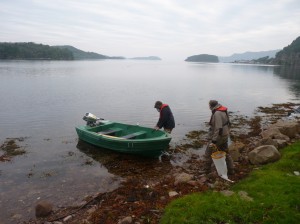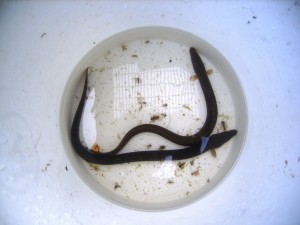Marine
Biologists update from Shieldaig: April 2015
April 13, 2015 by Marine Scotland Communications No Comments | Category Marine Directorate Science
Welcome to the first Biologist’s Update, designed to provide more information about the work that Marine Scotland Science are doing at the field station at Shieldaig.
Shieldaig is an amazing place for a biologist to work, situated by the shores of Loch Torridon where some of the most spectacular mountains in Britain meet the sea, and surrounded by iconic Scottish species: red deer, white tailed sea eagle, otter and salmon. Not forgetting, of course, the chief focus of our work at the field station, the sea trout.
Day to day and month to month, we see the seasons changing in this wild part of Scotland, and many of our tasks at Shieldaig reflect these seasons. In late winter we stock the river with trout eggs from our broodstock, placing them in artificial nests that mimic natural spawning redds. Later in the spring/summer we will count the number of fry emerging from these nests and monitor their progress. Spring also sees the trapping and tagging of seaward migrating sea trout smolts, which allows us to assess their return rates. We do this by monitoring the return of sea trout in late summer/autumn as fish return to the river to overwinter and reproduce, if mature. In late summer we also revisit the fry to assess their progress through to parr stages. In autumn we monitor the adult ‘silver’ eels leaving the river system on their seaward migration. Late autumn is the start of the cycle of life for trout as fish are breeding in the river, while our work cycle begins again in the late winter.
Some work continues throughout the year. For example every week we collect our plankton samples to estimate salmon louse larval densities. In these samples we also see the seasons come and go. Spring arrives in the sea, in the form of copepod blooms, even before the leaf buds have burst on the trees, and many other plankton life forms make their arrival and departure at predictable times through the year.
Scientists have worked here for many years, but the fish still have the capacity to surprise us. The summer and autumn of 2014 have been remarkable in terms of the silver eel migration at Shieldaig. These are mature eels leaving the river on their mysterious migration to their still unknown breeding place, and graveyard, somewhere near the Sargasso Sea. The ‘autumn’ run this year actually began in early July, two and half months ahead of the usual schedule. The run continued through into December and we recorded our highest ever biomass of migrating eels. Notable was the high proportion of larger female fish in the run. It is possible that the very mild winter of 2013/14, sandwiched between two warm summers provided good growing conditions for eels and allowed more of them to reach a threshold condition which permits migration. We monitor eel numbers leaving the Shieldaig river as part of Scotland’s commitment to the EU Regulation seeking to protect the stocks of this endangered species.
Further Information




Leave a comment